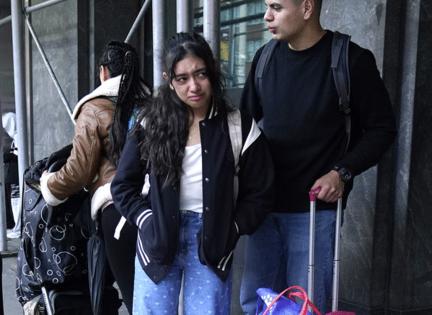NYC bungled shelter-stay limits for migrant families, says Comptroller Brad Lander
Published in News & Features
NEW YORK — New York City rolled out shelter-stay limits for migrant families in a “haphazard” way — without adequate policies or effective case management — Comptroller Brad Lander said Thursday.
Mayor Eric Adams announced a 60-day limit on how long migrant families could stay in shelters in October as an influx of asylum seekers strained the city’s shelter system. The policy was immediately panned by city workers, experts and elected officials who called it counterproductive for families trying to adjust to life in New York.
“We didn’t like the values behind the policy five months ago,” Lander said at a press conference outside The Row, a hotel turned emergency migrant shelter.
“But even if you think the policy was appropriate, you will find that it was implemented in a way that was entirely haphazard, that didn’t live up to its own goals and standards, that didn’t provide written policies to staff and contractors and that didn’t track the outcomes in any meaningful way,” he added.
By the end of last month, more than 10,200 families with children had received notices to vacate their shelters, according to a new analysis by the comptroller’s office. Among that group, more than half left the city’s care while 40% moved to other shelters and 9% stayed where they were, the audit showed. Some of the last cohort are remaining at an emergency tent shelter at Floyd Bennett Field in a far-flung part of Brooklyn.
“We are seeing parents choosing to live with their children in a field rather than continue to be shuffled from shelter to shelter throughout the city,” said Liza Schwartzwald, who directs family advocacy at the New York Immigration Coalition.
The shelter policy went into effect Jan. 9, with promises of intensive case management to help families with children land on their feet.
But the audit, based on a review of materials provided by the city, found those services were limited and “do little to help families achieve self-sufficiency.” Case management emphasized finding placements for families outside the shelter system, preferably beyond New York City, rather than stable housing, the comptroller’s office found.
“While several suggestions made in the comptroller’s report are already part of our policy, any ideas on how to improve our herculean work are welcome and will be considered,” said Adams spokeswoman Kayla Mamelak, citing updated training and guidance to staff as implementation has proceeded.
The analysis found written notices to families do not provide information about exemptions, such as for pregnant women, or reasonable accommodation. City Hall said it has policies on both and regularly provides trainings on how they work.
Specific blackout dates, when families cannot be ousted from their shelters for holidays or other reasons, had not been updated since the end of March, Lander said. While the city has policies that people can request their belongings be held for 10 days and get help changing their mailing addresses — a crucial step for families applying for asylum or work authorization — the process was unclear in materials shared with the comptroller’s office.
“When they move shelter to shelter, they lose track,” said Monica Sibri, an organizer with Algún Día, who worked with a mom selling candy with her children on the subway after they lost all of their belongings while moving.
The investigation was endorsed by City Council Speaker Adrienne Adams who, after sparring with the mayor in recent weeks, said in a statement the findings can “help guide the administration toward more effective policy solutions.”
Last month, an analysis by the City Council found nearly one in five children evicted from migrant shelters were no longer enrolled in the same schools, potentially disrupting the education of over 1,000 students. Multiple studies have found that students in temporary housing who switch schools — especially those who are not native English speakers — are more likely to be chronically absent and take longer to learn the language.
More than 195,000 migrants have come through the city’s care over the last two years, including 65,600 still in the shelter system and hundreds more people arriving each day, City Hall data show.
“Our 30- and 60-day notices are one tool in our very limited toolbox to help migrants to exit shelter because, as we have repeatedly said, New York City is long past its breaking point,” said Mamelak, who repeated calls for more federal help.
©2024 New York Daily News. Visit at nydailynews.com. Distributed by Tribune Content Agency, LLC.







Comments